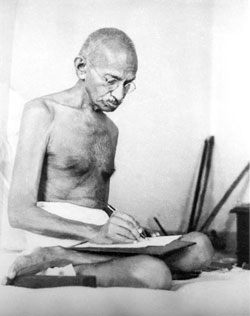Your Turn
The Assignment
Write an essay proposal that addresses the dark side of tolerance. Consider the attitude of someone who says that tolerating cold weather is easy. Is this different from saying “I like cold weather”? Yes, it is very different. Now consider a person who says, “I am tolerant of slow drivers.” Is this different from saying “I think slow drivers are, to some extent, driving badly”? Most will agree that, to some extent, the person is implying that meaning. For this assignment think about similar statements people say that at first appear to show an attitude of tolerance but really imply another meaning—possibly even of intolerance.
Mohandas Karamchand Gandhi (1869–1948) was the preeminent political and ideological leader of India during the Indian independence movement. Although Gandhi was not the originator of the principle of nonviolence, he was the first to apply it in the political field on a huge scale. The concept of nonviolence, ahimsa, and nonresistance has a long history in Indian thought and has had many revivals in other contexts. Gandhi explains his philosophy and way of life in his autobiography The Story of My Experiments with Truth.

Source: Ghandi (1942), ghandiserve.org, Wikimedia Commons
Gandhi once wrote, “I do not like the word tolerance, but could not think of a better one. Tolerance may imply a gratuitous assumption of the inferiority of other faiths to one’s own, whereas ahimsa [a rule of conduct which instructs us to “do no harm”] teaches us to entertain the same respect for the religious faiths of others as we accord to our own, thus admitting the imperfection of the latter.” This suggests that the need to be tolerant of something may imply a superior attitude toward what is being tolerated.
Think of at least three situations where people might claim a tolerant attitude without realizing that they are also claiming a superior position.
To what extent is this type of tolerance as bad as (or worse than) intolerance?
Write a proposal for this essay. Download the graphic organizer to fill in your answers and follow these steps:
- Read the assignment. State your thesis and paraphrase any references to quoted material in the assignment.
- Think about the assignment and decide on subtopics. (For the purpose of this model, try to think of three.)
- Show that you have a position. Start writing your proposal with a statement of your thesis.
- Show that you know the context of this issue. Give some background that will answer the question “Who cares?” (Perhaps also answer the questions “Who is Gandhi?” and “What did Gandhi mean when he
wrote this?”) - Show that you have a plan by giving a description of the parts of your essay—both the content and how that content will be presented.
- Show that there is broader significance. Give some vision of the desired effect of your essay.
Sample Response:
Proposal Model
In this essay I will defend the position that a tolerant attitude can imply a superior stance. Gandhi wrote that we should look at other religions as no less perfect than our own, understanding that ours is necessarily imperfect. Otherwise we “may imply a gratuitous assumption of the other faiths’ inferiority” to our own. Gandhi was considering tolerance only in the context of our attitudes toward other faiths than the ones we know, but the insight that tolerance is in many cases “not good enough” to count as morally blameless is applicable to other aspects of our lives beyond religion. I will consider “dark tolerance” in three different aspects: dark tolerance of the elderly, dark tolerance of people with learning disabilities, and dark tolerance of large-bodied people. I happen to know people in each of these categories (as most of us do), and I will discuss my struggle to be accepting of their differences in a non-superior way. I also will offer their comments in my essay, specifically in the sections that apply to them. I am going to look closely at the way in which such “tolerance” affects these people, but I will also comment on the broader issues of the larger population in each of these categories. Finally I’ll show how the ideas I’m presenting can be applied to many other parts of our lives.
Close